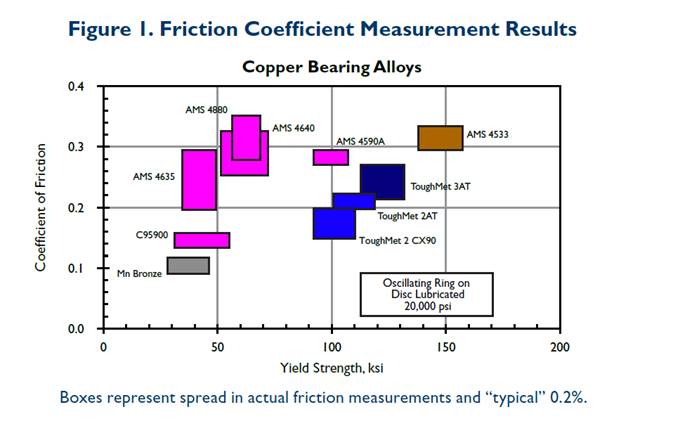Tribological behavior is a complex phenomenon in metals and alloys. Many factors influence the interaction between two sliding materials and, importantly, confound our ability to predict life in mechanical components. Motion design factors such as loading, lubrication, roughness and relative speed can significantly vary through the life cycle of contacting parts. Important material attributes also affect the life of sliding components and include strength, hardness, elastic modulus, thermal conductivity, ductility, corrosion and fatigue resistance and microstructure, to name a few.
The purpose of this blog is to look at only one aspect of the tribological spectrum, namely, coefficient of friction—a parameter that is frequently used to screen materials for use in bearing applications. In this survey, commonly available copper alloys used in journal-type bearings are assessed for their behavior under highly loaded conditions with lubrication.
In any application involving sliding surfaces it is important to understand that no single material property of a material governs the frictional response. For example, low coefficient of friction may not guarantee success in a design which relies on only modest sections for assembly support—high strength also may be needed to fulfill this support need. This might be the case for a bronze shaft operating against a steel segment on rotating machinery, for example, where the shaft is heavily loaded in bending. Generally, though, designs undoubtedly command freedom from galling and seizing early in the life cycle, so good friction characteristics (i.e. low coefficient of friction) are desirable.
Dynamic coefficient of friction was the focus for this survey and it was decided early that bi-directional cycling would be used to support aerospace and off-road equipment applications where the relative motion shows a reversal in its normal use. That is, high speed oneway rotational motion was not considered within the scope of the evaluation.
The test utilized small cylinders machined from rods of the respective copper alloys. These test specimens were end-loaded onto chrome plated (QQC-C-320) discs of 4140 heat treated to HRC 53, typical of many aerospace applications. This “Ring on Disc” test utilized liberal amounts of AeroShell 33 grease at the start of the +/-45 degree 4.3 Hz rotational oscillation of the specimen. The loading was maintained at 20 ksi (140 MPa) on the ~10 microinch (0.25 μm) finishes of the mating surfaces. Peak relative motion was at a speed of 10 inch/s (250 mm/s).
The test equipment was designed to monitor torque, control speed, maintain the prescribed load and measure temperature adjacent to the mating interface, all in real time. The coefficient of friction was calculated continuously. The coefficient of friction (μ) and temperature were stable after about 1,000 of the 2,500 cycles and in no case was galling observed. Data are presented in Table 1, showing relative yield strength comparisons, too. Figure 1 presents measurements as bars, with the width of each bar relating to the span in friction coefficient obtained during two independent tests. The test is probably accurate in describing material behavior to approximately +/-0.05 based on experience with the test.
There are no obvious correlations between strength and coefficient of friction. However, grouping the alloys by metallurgical family suggests the following:
The aluminum bronzes (AMS 4880, AMS 4640, AMS 4590A) exhibit μ of about 0.30, independent of strength (60 –100 ksi [410 -690 MPa]) and whether cast or wrought. This could be a result of microstructures containing abrasive alumina, a natural microconstituent in this class of alloys.
The low strength alloys exhibit μ of about 0.13 or so and are very soft, strengthened by only solid solution hardening. The strength of C67300 and C95900 is only about 40 ksi (275 MPa) and there may be some tendency for better accommodation of the mating surfaces at the low cycles in this test.
There appears to be a strength-μ trend in the classic precipitation hardenable alloys (ToughMet® 2 [CX90 and AT] alloy, ToughMet 3 AT alloy, and Copper Beryllium Alloy 25 AT). These alloys span a yield strength range of 100 –150 ksi (690 -1035 MPa) with friction coefficient varying from about 0.15 to 0.30, consistent with the theme of a strength correlation. Friction testing was designed to provide an estimate of dynamic coefficient of friction for a wide range of copper alloys used in tribological applications. Wear resistance, usually measured by dimensional change or weight loss, is a distinctly different feature of alloy performance. Ongoing testing and evaluation using a similar test for longer periods will be the subject of future technical reports.


Processing beryllium-containing alloys poses a health risk if safe practices are not followed. Inhalation of airborne beryllium can cause serious lung diseases in some individuals. Occupational safety and health regulatory agencies worldwide have set mandatory limits on occupational respiratory exposures. Read and follow the guidance in the Safety Data Sheet (SDS) before working with this material. The SDS and additional important beryllium health and safety information and guidance can be found at berylliumsafety.com, berylliumsafety.eu and Materion.com.
For questions on safe practices for beryllium-containing alloys, contact the Materion Product Stewardship Group at +1.800.862.4118 or contact us by e mail at Materion-PS@Materion.com.